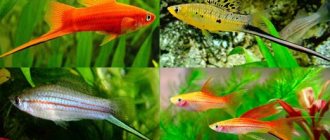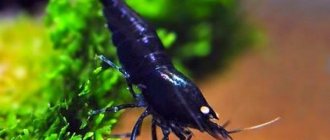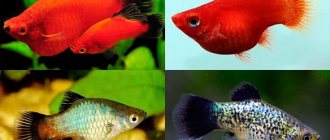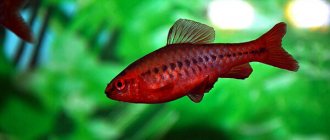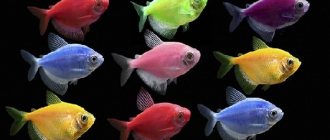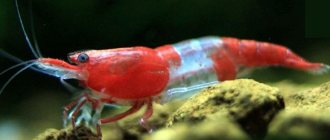Neocaridina davidi var. "Blue Dream"
Kingdom: animals;
Phylum: arthropod;
Subtype: crustaceans;
Genus: neocaridines;
Aquarium volume: it is advisable to use aquariums from 40 liters, however, a small number of shrimp can live in small aquariums ~ 10 liters;
Content difficulties: easy, medium.
Water parameters: temperature: 20–28 0С; pH 6.0 – 8.0 pH; total hardness up to 20° dGh; carbonate hardness up to 14° dKh;
Life expectancy: up to 2 years;
Body length: up to 3cm;
Color: blue;
Diet: omnivore;
Synonyms: blue dream shrimp, blue velvet shrimp.
In nature, Neocaridina shrimp are common in China, Taiwan and Korea in small streams, overgrown ponds and flooded meadows.
Of all the color varieties of Neocaridina davidi, blue is the most confusing, as there are a large number of different variations of blue shrimp, such as: blue dream, blue fairy, blue jelly, blue rili, blue velvet and others. In addition, each individual variety can be found in different shades and levels of color coverage, which directly affects popularity and cost.
In this article we will look at the different types of blue dream shrimp.
Like all varieties of Neocaridina davidi, including the most popular red cherry , Blue Dream shrimp is obtained through selective breeding of wild shrimp. The resulting specimens are not evenly colored and range from deep, dark and opaque blue to light and mottled.
Blue dream shrimp photo
Shrimp with completely opaque coloration are much more difficult to hatch than shrimp with translucent areas. This process involves continuous selective breeding and the removal of large numbers of unsuitable individuals.
Appearance of Blue Dream (blue shrimp)
Blue Dream or Blue Velvet (Blue Velvet), or (Blue, blue shrimp) was bred artificially by selection of the Neocardina shrimp (Neocaridina heteropoda). Blue shrimp is the result of joint work of Japanese and German scientists.
They are not capricious in maintenance, nutrition and care. In addition to their attractive and unusual appearance, they clean the aquarium of organic debris and excess algae.
Like other types of shrimp, Blue Dream is a peaceful shrimp with a striking blue color, sometimes with dark splashes. Her body is covered with a dense shell consisting of chitin. It is hard and not elastic, so during intensive growth the shrimp shed it. This is called the molting period. During molting, shrimp are at their most unprotected and sensitive. Shell shells are a source of useful substances, so there is no need to remove them from the aquarium - they will be eaten.
Shrimp move along the bottom of the aquarium using five pairs of limbs. The jaws hold and deliver food to the mouth. Multi-colored aquarium inhabitants have long antennae on their heads, which have tactile and olfactory functions. The movable long tail makes it possible to move in small jumps, so they can quickly hide from predators. On average, the life of a shrimp is up to 2 years.
The intensity and intensity of color depends on genetic characteristics and living conditions in the aquarium. The Blue Dream Shrimp should have a deep, blue color throughout the body and limbs. Some naturally occurring Blue Dream shrimp are purple or lighter in color.
Shrimp habitat is the most suitable habitat for shrimp.
Is it possible to find blue shrimp in natural conditions?
No, you won’t be able to find the bright Blue Dream shrimp in nature, because it is a selective form obtained as a result of the work of breeders. Neocaridina heteropoda, a freshwater shrimp inhabiting slow-flowing rivers, was taken as the parent specimen. It is found in China and Korea, has a simple appearance, and looks transparent.
It turns out that not only fish, but also shrimp can live in home aquariums. Tell us about your experience, perhaps you have such pets? Leave photos of your shrimp aquariums in the comments.
Table of basic parameters of maintenance, care and nutrition:
| What should be the volume of the aquarium? | for 10-15 shrimp you need an aquarium of 20 liters |
| What should be the temperature in the aquarium? | from +22-26° C |
| What pH should it be | from 6.5-8 pH |
| What should be the stiffness? | from 5-18° dH |
| What should the substrate be? | thin grains of the substrate (soil) ranging in size from 3-4 mm |
| What kind of lighting should there be? | moderate |
| What should be the movement of water | moderate |
| Aquarium Shrimp Size | size of females up to 3 cm, males up to 2 cm |
| What does it eat? | aquarium algae and leftover flakes of fish food, feeding once a day with dry food for shrimp or bottom fish |
| Who is compatible with in an aquarium? | get along with small non-aggressive fish species |
| Lifespan | up to 2 years |
Sex differences
At first it seems that there are no gender differences. In reality, there are several ways to determine gender:
- Females are larger, males rarely exceed 2 cm in length;
- The color of females is more intense;
- Females are more active and energetic;
- In females the belly is rounded, in males the body is elongated;
- In females, the abdominal limbs are equipped with a saddle for bearing eggs.
Maintenance and care
An important rule for shrimp and fish living together is the creation of a complex landscape that is designed for shelter for arthropods. A suitable relief is created by placing stones, driftwood, grottoes, and the bottom of the aquarium is covered with small pebbles or sandy soil 3-4 mm thick.
Blue Dream is picky about the presence of vegetation, so the aquarium should have a large amount of algae, ferns and a variety of mosses.
Another important factor in keeping blue shrimp is water quality. Blue Dream shrimp love clean, oxygenated water with good filtration and aeration.
The water parameters are as follows:
- temperature from +22-26°C;
- hardness from 5-18° dH;
- acidity from 6.5-8 pH.
The Blue Dream shrimp has a strong immune system, but changing the water in the aquarium to settled water should be done with caution, in doses, to prevent a sharp temperature change and disruption of the acid balance.
The content of copper, ammonia and nitrates in the water has a detrimental effect on the life of blue shrimp and can lead to their death. Mineral deficiency affects the strength of the armor layer. Therefore, before placing Blue Dream in the aquarium, a stable optimal biological balance should be ensured.
The volume of the aquarium depends on the number of individuals living in it and can vary from 5 to 50 liters. For 10-15 shrimp you need an aquarium of 20 liters.
Due to the crustacean's jumping ability, the top of the aquarium should be covered.
Shrimp diseases
Crustaceans are less susceptible to disease than fish, but they themselves are often carriers of pathogenic microorganisms.
Unsuitable conditions can weaken the immune system of shrimp and make it susceptible to infections and parasites: dirty water, increased pH and hardness, and unsuitable temperature conditions.
Several types of parasitic organisms pose a threat.
| Pathogens | Causes of appearance, symptoms, harm caused | Treatment |
| Ciliates of the families Vorticellidae (suvoiki) and Stentoridae (ciliates) | Colonies develop rapidly when the nitrogen cycle is disrupted, caused by overfeeding and untimely cleaning of the aquarium. Not only shrimp, but also shells of snails, plants, and soft tissues of fish are affected by short white deposits resembling mold. Ciliates cause secondary bacterial and fungal infections | Eliminate the causes of water pollution |
| Parasitic algae (false "mycosis") | Pathogens develop in dirty water overpopulated with shrimp. The algae, which feeds on the heat of the host, reveals itself through spores containing chlorophyll. Bright yellow-green growths appear under the abdomen and front legs. A serious consequence of the disease is a disruption of the reproduction process | Clean the aquarium from bottom sediments and dead larvae, increase water circulation. Treat the water with the preparation – malachite green. Place a large population of crustaceans in different vessels |
| Parasitic worms of the genus Scutariella | These organisms are almost always present in the aquatic environment. Small white worms no more than 2 mm in length can be seen in unprotected parts of the body - the abdomen, the area of the antennae and eyes, and the gills. Blood-sucking parasites cause lethargy and irritability | Treatment is provided with antiparasitic drugs (Sera Tremazol, Argumor Aquarium Munster) or salt. For individual shrimp, use pure table salt: partially replacing water, add salt until a concentration of 3-5 g per 1 liter is reached. The temperature is maintained within 25-28°C, aeration is enhanced. Treatment lasts several weeks until the worms disappear completely. Then the water is also gradually replaced until the salt is completely removed. Salt baths are suitable for sharing containers with fish: dilute 2-3 teaspoons of salt with 1 liter of aquarium water in a shallow vessel. The shrimp are placed in the solution for 10-20 minutes. The procedure is repeated 3 times, one per week. |
| Single-celled parasites Microsporid Thelohania contejani, causing porcelain disease | The disease occurs due to the stress experienced by individuals with weakened immune systems during transportation. The pathogens live in the muscles of shrimp. The limbs become hard and immobile. A day later, the individuals are completely paralyzed. After the onset of the first symptoms, death is inevitable | For treatment, crustaceans are given feed flakes soaked in malachite green oxalate. Also, dead shrimp are immediately removed from the aquarium to avoid infecting others. |
| The filamentous fungus Fusarium spp, which causes fusarium ("black gills") | Arthropods can become infected from single-celled vector organisms or live food containing nauplii. Black color of the gills is the main symptom. They acquire this color due to the overgrown mycelium of mushrooms. Infected individuals develop fusariotoxicosis, which leads to gastrointestinal upset and paralysis. Shrimp die from suffocation | To improve the health of the population, medications such as nystatin and azalomycin F are used. 1 tablet is diluted in 20 liters of water for 5 days. Then replace half the water in the aquarium |
What to feed blue shrimp
The search for food is carried out by special receptors that recognize food. Having sensed prey, the shrimp will run in a circle until it jumps on its “prey.” Algae make up a very large part of their diet and help maintain their already strong immune system.
Their diet includes:
- food for aquarium fish;
- feed specialized for shrimp;
- vegetables and fruits (pumpkin, cucumbers, zucchini, scalded with boiling water, boiled green peas);
- leaves (currant, cherry, walnut, chestnut, maple, birch, cherry and raspberry) as a supplement.
Plants must be given in a dried state. Dry nettle leaves contain a maximum of useful substances for the life of shrimp.
If there is a small amount of algae in the aquarium, you need to use food containing spirulina.
Once every few days, shrimp should be fed with daphnia as a protein supplement, canned and live food, alternating them with each other to ensure a balanced, varied diet.
The process of feeding shrimp should begin at the same time, mainly during the period of increased activity (an hour after turning on the light) 1 or 2 times a day. For feeding, it is advisable to use special feeders. Periodically, you need to create a fasting time of 1 day a week.
General description of shrimp and natural habitats
It all started with the import of cherry shrimp to Europe, which won the hearts of aquarists with its beauty. In the future, this gave impetus to their breeding, crossing, and maintenance.
Many crustaceans are similar in appearance, but are strikingly different in their care and nutrition.
Their size varies from 1 to 40 cm. The body is covered with a layer of chitin. They have three pairs of mandibles instead of claws, which are responsible for movement. They have a well-developed tail and long mustache. They have a good ability to roll their eyes. The size of the population depends on the size of the reservoir. They are unpretentious in their diet: they eat everything.
Photo gallery of shrimp:
In the ecosystem they are found in estuaries, small streams, freshwater and salt waters. A good saturation of the aquatic environment with oxygen is a must. Imported from Southeast Asian countries.
Blue Dream shrimp reproduction, breeding
Under proper living conditions, Blue Dream shrimp reproduce unhindered and produce healthy offspring. When they go through the process of adaptation in the aquarium, females produce up to 30 fry per month. The distinctive quality of this type of arthropod is that they interbreed only between their own species, but not with representatives of other species.
The female, ready for fertilization, releases special chemicals into the water, thereby giving a sign to the male, who throws out his biological material. This way the eggs are fertilized. Next, the female carries the eggs, protects them from dirt, saturates them with oxygen, and discards dead eggs. The female is capable of producing about 30 eggs at a time. The development process from egg to young shrimp lasts about a month.
Babies are born tiny and immediately hide in a shelter. To increase the number of surviving fry, it is recommended to plant them separately. The young animals may turn out greenish, gray-brown or transparent; the “blue” gene must be constantly fixed. The blue pigment of a young shrimp intensifies as it grows. Sexual maturity of the shrimp occurs at the age of 3 months.
Reviews
To summarize, we can say that the blue dream shrimp is unpretentious, easy to keep and breed. Organisms live in a container with fresh, neutral or slightly alkaline water. An aquarium with a volume of at least 5 liters must be equipped with a layer of soil and abundantly planted with vegetation. Plants provide shelter and a source of food for crustaceans. A filter, lighting and a closing lid are required. Some processed vegetables and bottom fish tablets are suitable as food. If you follow simple rules, the blue shrimp will become a bright decoration of a living water corner along with other inhabitants.
Have you already wanted to buy blue shrimp? Share in the comments!
Compatible with fish and other shrimp
The safe coexistence of shrimp with aquarium fish depends on the size of the aquarium, the number of inhabitants, temperature indicators and the characteristics of each type of inhabitant.
Blue Dream shrimp can coexist peacefully with:
- ampularia (a type of aquarium snail);
- catfish (only non-predatory species);
- chain catfish (the only large fish that is adjacent to arthropods, as it is herbivorous);
- Neon (peace-loving, able to get along with almost all inhabitants of aquariums);
- Guppies (can only be dangerous to baby shrimp);
- Danio (non-conflict aquarium fish);
- microrasbor (small spotted fish are friends with shrimp);
- Pecilia (an aquarium fish that can live peacefully with shrimp);
- parotocinclus (an aquarium fish that quietly coexists with shrimp).
It is strictly forbidden to keep shrimp in the same area as Cichlids, which are capable of swallowing blue shrimp. Apistograms and Angelfish can peck at Blue Dream, causing significant damage or eating it. Helenas (a type of predatory snail) are greedy for Blue Dream fry.
Before introducing various inhabitants into the aquarium with shrimp, it is recommended to examine the behavior of the fish for the presence of arthropods. To do this, you can place a couple for a couple in a separate container and observe the reaction of both representatives to each other.
If you follow the basic rules for maintaining and caring for Blue Dream, it will become a true decoration of the aquarium. It will also delight its owner not only with beauty, but also with numerous offspring. Blue Dream in the vicinity of other types of colored shrimp (yellow, red, orange individuals) will create a riot of colors in the aquarium.
Aquarium mates
Blue velvet shrimp are best kept separately in a shrimp tank. This species cannot be kept with other neocaridines, including wild ones - all types of neocaridines interbreed, which will inevitably lead to discoloration. It is better not to keep it with fish, or only with small fish. The exception is algae eaters, such as Otocinclus affinis, Ancistrus, and Chinese algae eaters. Adult shrimp can get along with corydoras and small fish, but young shrimp can be mistaken for food.
Mr. Tail recommends: variety of species
There are a large number of shrimp in nature. Before purchasing, it is better to immediately familiarize yourself with their features in order to avoid further difficulties in maintenance. There are two families: Caridina (crystals, babaulti) and Neocaridina (cherry). The table shows common options.
| Variety | Description |
| Amano | Verdepomova with brown spots, capricious, eats all vegetation. Cleans the tank well. |
| Red crystal | White with red stripes. Fastidious in care. The temperature should be +26 °C, does not eat much, has a weakened immune system. |
| Yellow | It is necessary to monitor the purity of the water; it reproduces easily - 30 children in one mating season. |
| Glass (Clear, Indian, Ghost) | Life expectancy is 1.5 years. Height is 5 cm. Small fish will be good neighbors. Considered a cleaner. The food you eat can affect your coloring. |
| Tiger | It reaches 4 cm in height, requires a 50 liter tank, black and green. |
| Blue brindle | Obtained as a result of selection. The eyes are orange. It does not require special care. |
| Blue Dream | Size 3 cm, rarely gets sick, reproduces well. Lives 3 years. |
| Macrobrachium Rosenberg | The largest representative, reaches a length of 40 cm. It has long jaws and a serrated red nose. The claws are dark black. It eats not only plants, but also fish, and tears up the soil. |
| Cherry | Unpretentious, 2.5-3 cm in size, suitable for a 10 liter aquarium. It can be white, blue, burgundy, red, gold (it all depends on the conditions of detention). Easily propagated. |
| Black crystal (Neocardina black) | Colored in all shades of black, it is a rare species. |
| Bumblebee | The colors are varied (blue-white, yellow, white-red). Its length is 2-3 cm. |
| Filter (Banana) | It has peculiar “fans” that catch planktonic organisms and organomineral particles. Dark yellowish-green, red-yellow with horizontal stripes. Unwillful. Can reach 10 cm. |
| Riley | Easy to care for, undemanding to water parameters, eats everything. Consists of two colors: one is rich (orange), the other is a translucent type of the first. On average 2.5 cm. |
| Cardinal | Very whimsical, there are white paws in front, thanks to them it moves quickly. The main color is red with varying brightness. There are small white spots on top. Grows up to 1.5-2 cm. |
| Harlequin | The smallest, 1.2 cm long. Shy, has difficulty adapting to a new place. It has a red, white, black tint. |
| Red Nose | It has a red or pink growth on the cephalothorax. The body is transparent with blue. Size – 3 cm. If broken, the rostrum is easily restored. |
| Ring-armed | The limbs have peculiar tentacles in the form of black and red rings. Aggressive. Size – 7 cm. |
| Serrated | Transparent with diametric black stripes with yellow dots. Reaches 9-11 cm. Long-lived (5 years). |
| Nutcracker | Has asymmetrical tentacles. With its clicking it can create a wave that can break the glass of an aquarium. Length – 5 cm. |
| Far Eastern | Translucent with a shell with black stripes. Color may vary depending on food and soil. |
| White Pearl | White-gray. So transparent that the sex of the crustacean is easily determined: the larvae and ovaries are visible. Brought out by selection. Size 2-2.5 cm. |
| Blue Pearl | Obtained by crossing. You can determine its condition by its color: the paler, the more weakened the individual is. |
| Blue aura | The most beautiful of the Atyidae family, rare. Easily propagated. After molting, it loses its color for a couple of days, and then it is restored again. |
| Blue-footed bee | Gray body with blue spots on the tail, red mustache and the same paws. |
| Red Hawaiian | In a critical situation, it changes its color and becomes invisible, masquerading as surrounding objects. Peace-loving, very patient. Life expectancy is 20 years. |
| Japanese | The outfit is festive, slightly transparent, brownish with a black stripe, girls’ claws are orange, boys’ claws are red brick. Aggressive. 6-8 cm in size. |
| Inle lake shrimp | It is considered a predator of the genus Palaemonidae. The body is transparent with red stripes, 3 cm long. |
| Mandarin duck | Orange with streaks and red dots on the side |
| Ceylon | Constantly on the move. Filters and aeration are required, as well as changing 1/3 of the water every week. Color range: from brown to blue. Length – 1.8-2.5 cm. |
| Nigerian (Atiya) | There are no claws. Blue-gray, blue color. Quite large 14-18 cm. Obtains food by filtration. |
| Nigerian floating | Transparent. It differs from others in its movement - it seems to soar, floating above the surface. |
| Khanka | Active, freedom-loving, requires an aquarium size of 7-10 liters, slightly transparent with long mustaches, reminiscent of a small catfish. Excellent cleaner. The water should be very dry. |
| Ninja | An excellent master of disguise, she changes her color depending on where she perches. However, creating conditions for reproduction is almost impossible. They live 2-3 years. |
The size of crustaceans also depends on gender: females are usually larger than males.



